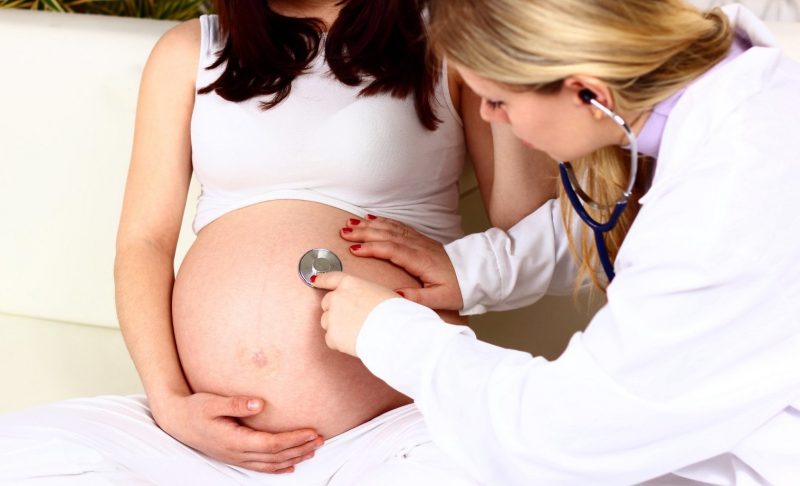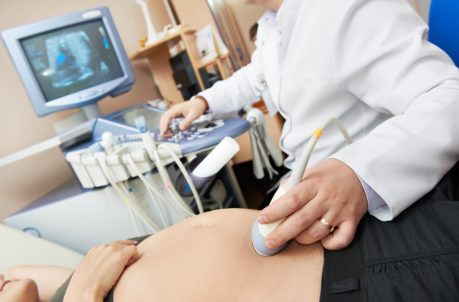The antenatal death of the fetus is one of the worst verdicts for a woman who is expecting the birth of a baby. What causes this pathology, how to recognize and avoid it, is described in detail in this article.
Material Content:
What is antenatal fetal death?
Antenatal death is the death of the fetus in the womb at a period of 9 to 42 weeks of gestation. This is a fairly common occurrence. According to statistics, there are one such case per 200 pregnancies.
The death of the unborn child is very difficult news for a woman, and many who have experienced this misfortune are afraid to become pregnant again. Fortunately, according to the same statistics, in healthy women this is extremely rare.
Antenatal fetal death for up to 28 weeks is also called missed pregnancy. It implies the cessation of development and death of the embryo and at the earliest dates (up to 9 weeks).
Causes of pathology
Sometimes antenatal fetal death can occur in healthy women, even if the pregnancy has been normal.
But in most cases, the causes of pathology are:
- infectious diseases of the pregnant woman (ARVI, rubella, pneumonia, measles, hepatitis);
- vitamin deficiency;
- congenital heart disease, heart failure, serious disorders of the liver and kidneys, low hemoglobin in the blood of the expectant mother;
- diabetes mellitus and other endocrine disorders;
- infections of the pelvic organs in a pregnant woman;
- Rhesus conflict, incompatibility of blood groups of the mother and fetus;
- preeclampsia - a pathology of the second half of pregnancy, which is often manifested by edema, increased blood pressure, seizures, the presence of a significant amount of protein in the urine;
- congenital abnormalities of the fetus;
- various disorders in the placenta;
- polyhydramnios or oligohydramnios;
- umbilical cord entanglement, the true knot of the umbilical cord;
- injuries to the abdomen of a pregnant woman;
- alcohol abuse, smoking, drug use;
- taking pharmaceutical preparations contraindicated for pregnant women;
- ionizing radiation;
- various intoxications.
Development with multiple pregnancy
The death of one of the fetuses is recorded in 6% of cases of multiple pregnancy. The frequency of this phenomenon is determined by the degree of multiple pregnancy and chorionicity (the correspondence of the number of placentas to the number of embryos). Thus, the risk of intrauterine death of one of the fetuses is higher in triplets than in twins. Also, antenatal death is more common in monochorionic twins (when two fetuses have one placenta) than in dichoric twins (when each fetus has its own placenta).
Features of the pathology depend on the gestational age:
- In the first trimester of multiple pregnancy (up to 10 weeks), the phenomenon of the “missing twin” occurs when a dead embryo is rejected or absorbed. In the case of dichoric twins, the death of one embryo does not affect the health of the second. If there is one chorion, there is a high risk of cerebral palsy and intrauterine developmental disorders in the surviving twin.
- The end of the first - the beginning of the second trimester. At this stage, the dead fetus is mummified, becomes smaller and squeezed alive. With the common chorion, the surviving twin often has serious congenital developmental disorders caused by the decomposition products of the deceased, therefore mothers usually offer to terminate the pregnancy.
- From 25 to 34 weeks of pregnancy with a general chorion, the surviving fetus is examined using ultrasound and MRI. Based on the results, they decide on an urgent delivery or further pregnancy management.
- Antenatal death of the fetus in the later stages of multiple pregnancy (more than 34 weeks) requires urgent delivery.
With multiple pregnancy and the alleged death of the fetus, the woman is hospitalized, the gestational age, the number of chorions are determined, the presence of concomitant diseases is established and a decision is made on further actions.
With the death of one fetus in dichoric twins, urgent delivery, as a rule, is not required. A pregnant woman is monitored, body temperature, blood pressure are monitored, regular blood tests are performed. The condition of a living fetus is assessed using dopplerometry and other research methods. After childbirth, an autopsy is performed on the deceased twin to determine the causes of his death.
Symptoms and signs
The main sign of pathology is a prolonged absence of signs of fetal movement. If the expectant mother already felt the daily periodic tremors of the baby, she should be alerted by their absence during the day. In this case, panic is not worth it, because the woman simply could not notice the movements of the child. To make sure that everything is fine with the baby and make him move a little, you can eat something sweet or lie on your back.
If after taking the measures the child has not moved for a long time, you should consult a doctor as soon as possible. This phenomenon may also indicate acute fetal hypoxia.
And also there are other signs of the death of the baby in the womb:
- general malaise;
- sagging breasts;
- soreness and heaviness in the lower abdomen;
- lack of fetal heartbeat;
- decreased tone and stopping the growth of the uterus.
If the dead fetus is in the womb for more than two weeks, the following symptoms join:
- high body temperature (up to 39 degrees);
- dizziness and headaches;
- drowsiness;
- stomach ache;
- confusion.
Diagnostic measures
Having discovered the symptoms of antenatal fetal death, a woman should immediately visit a doctor who is pregnant. The specialist will conduct an examination and appoint an appropriate examination.
Pathology is confirmed by the following hardware and laboratory methods:
- Ultrasound The study reveals the absence of a heartbeat from 9-10 weeks of pregnancy.
- Phonocardiography is a method for determining sound waves that appear as a result of a fetal heartbeat in order to evaluate the activity of this organ. It is used from 13-15 weeks of pregnancy.
- Auscultation - listening to a heartbeat with a stethoscope. It is applied from the 20th week of pregnancy.
- Cardiotocography (CTG) is a method of analyzing uterine contractions and fetal cardiac activity in dynamics using dopplerometry and phonocardiography.
- Determination of the level of hormones in the blood. With intrauterine fetal death, the concentration of progesterone, estriol and placental lactogen decreases.
- Amnioscopy - examination of the fetal bladder through the birth canal or abdominal wall. On the first day after the death of the unborn baby, greenish amniotic fluid is observed. Later, blood impurities appear.
- Roentgenography. The method is used in some cases of diagnosis of pathology.
Medical intervention with this diagnosis
The goal of medical intervention in this pathology is to extract the dead fetus from the uterus. The type of measures taken depends on the gestational age.
- First trimester. After the death of the fetus for a period of less than 10 weeks, a miscarriage often occurs. If this does not happen, curettage of the uterine cavity is performed (medical abortion).
- In the second trimester, drugs that stimulate labor (oxytocin) are used to naturally release the dead fetus.
- In the third trimester, labor begins spontaneously or is stimulated.
In some situations, a caesarean section is indicated in the later stages. When a dead fetus for some reason does not pass through the birth canal, fruit-destroying operations are performed.
After removing the dead fetus, a woman is prescribed a course of antibiotic therapy to prevent complications. Next, the causes of the antenatal death of the fetus are determined, and measures are taken to eliminate them. And also patients often need a consultation with a psychologist.
Possible consequences
With timely access to a doctor, intrauterine death of the fetus will not entail complications. As a rule, 6-12 months after treatment, the next pregnancy may occur, which will end safely.

If the patient turned to the doctors later than two weeks after the death of the fetus, it is very likely that serious bacterial complications can develop, up to sepsis, which can be fatal.
And also rare cases are known when a dead fetus has been asymptomatic in the womb for years. This is possible with mummification (occurs when the cord is entangled, multiple pregnancy) or petrification (petrification, calcification). The latter involves the accumulation of calcium compounds in the tissues of a dead fetus, which is most common in ectopic pregnancy.
How to prevent fetal death
Certain measures to prevent such a pathology must be taken at the stage of pregnancy planning. Before conception, a woman should undergo an examination in order to detect and subsequently treat somatic diseases, infections and other pathologies that may affect the fetal development of the unborn child.
At the stage of pregnancy planning, it is necessary to take tests for the so-called TORCH infections (herpes, rubella, toxoplasmosis, chlamydia). Diseases of this group can cause not only intrauterine death, but also serious abnormalities in the development of the fetus.
Prevention of fetal death during pregnancy:
- exclusion of bad habits;
- balanced nutrition, intake of special vitamin complexes;
- optimal working conditions for the pregnant woman (lack of heavy physical exertion, ionizing radiation, contact with toxic substances, prolonged sitting position and other negative factors);
- regular visits to the gynecologist conducting the pregnancy;
- monthly urinalysis;
- prevention of abdominal injuries;
- prevention and timely treatment of influenza and other infections;
- taking medications exclusively as directed by a doctor.
The death of a child in the womb is a tragic and, unfortunately, a frequent pathology. In order to significantly reduce the risk of its occurrence, you must carefully monitor your health and follow the recommendations of a specialist.








































